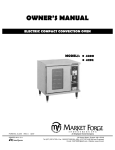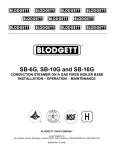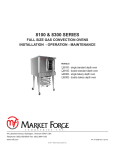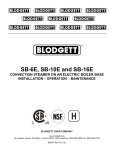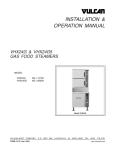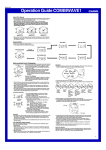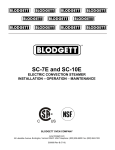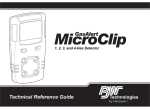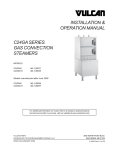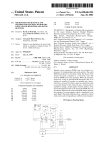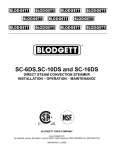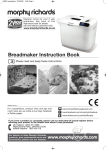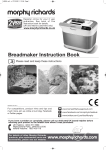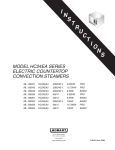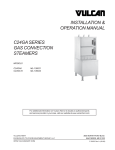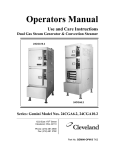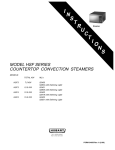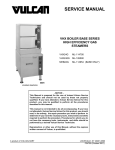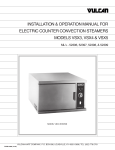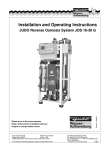Download Market Forge Industries 4200 Owner`s manual
Transcript
INSTALLATION, OPERATION AND PARTS MANUAL ELECTRIC CONVECTION STEAMER MODELS: PS-3E PS-6E S-6011 REV.A 11/09 1 OWNER’S MANUAL ELECTRIC COMPACT CONVECTION OVEN MODELS: ● 4200 ● 4292 FORM NO.: S-2374 REV: A PRINTED IN U. S. A. 02/07 An Employee Owned Company 35 Garvey Street • Everett • MA • 02149 Tel: (617) 387-47100 • Fax: 1-800-227-2659 (Ex. MA) • (617) 387-4456 (MA and Overseas) E-mail: [email protected] • Website: www.mfii.com TABLE OF CONTENTS INTRODUCTION DESCRIPTION.................................................................................................................................1 OVEN COMPONENTS ....................................................................................................................1 BASIC FUNCTIONING ....................................................................................................................1 SERVICE .........................................................................................................................................1 INSTALLATION RECEIVING .....................................................................................................................................2 ASSEMBLY - VENT BOX ATTACHMENT ........................................................................................2 SINGLE OVEN - 4” LEGS & 28” LEGS WITH SHELF . ...................................................................2 STACKED OVENS - 18” LEGS WITH SHELF .................................................................................3 ELECTRICAL CONNECTION . ........................................................................................................3 OVEN CHECKOUT & ADJUSTMENTS ...........................................................................................4 THERMOSTAT CALIBRATION (OLD & NEW STYLES) . ................................................................4 THERMOSTAT DIAL PLATE CALIBRATION (NEW STYLE) ...........................................................4 WIRING DIAGRAM ..........................................................................................................................5 OPERATION PRINCIPLES OF OPERATION . ......................................................................................................6 CONTROLS .....................................................................................................................................6 PRE-HEATING . ...............................................................................................................................6 OPERATION ....................................................................................................................................6 MAINTENANCE CLEANING . .....................................................................................................................................7 REMOVAL & REPLACEMENT PARTS ............................................................................................7 DOOR REMOVAL ............................................................................................................................7 DOOR REPLACEMENT (OLD STYLE)............................................................................................7 OVEN LINER GASKET REMOVAL .................................................................................................7 GASKET REPLACEMENT ..............................................................................................................7 BLOWER WHEEL REMOVAL & REPLACEMENT ..........................................................................7 MOTOR REMOVAL & REPLACEMENT ..........................................................................................7 SWITCH REMOVAL & REPLACEMENT .........................................................................................8 CONTACTOR REMOVAL & REPLACEMENT..................................................................................8 THERMOSTAT REMOVAL & REPLACEMENT ...............................................................................8 HEATER ELEMENT REMOVAL & REPLACEMENT .......................................................................8 DOOR INTERLOCK SWITCH BRACKET (OLD STYLE) REMOVAL & REPLACEMENT ..............................................................................................................................8 NEW STYLE INTERLOCK SWITCH REMOVAL, REPLACEMENT & PARTS.................................9 HI-LIMIT REMOVAL & REPLACEMENT .........................................................................................9 TROUBLE-SHOOTING GENERAL ........................................................................................................................................10 TROUBLE-SHOOTING GUIDE .......................................................................................................10 WIRING . ..........................................................................................................................................11 ELECTRICAL FAULT ISOLATION GUIDE . .....................................................................................11 ELECTRICAL CONNECTIONS - CONTROL BOARD .....................................................................12 ILLUSTRATED PARTS LIST GENERAL ........................................................................................................................................13 ORDERING INFORMATION . ..........................................................................................................13 4200 COMPACT CONVECTION OVEN & PARTS ..........................................................................13-14 CONTROL PANEL, OPEN & PARTS . ............................................................................................15 RIGHT SIDE VIEW & PARTS .........................................................................................................16 DOOR ASSEMBLY & PARTS .........................................................................................................17 INSIDE OVEN COMPARTMENT PARTS LIST ................................................................................18 4200/4292 REVERSING SWING OF DOOR (S) .............................................................................18 INTRODUCTION This service and parts manual contains general information, installation, operation, principles of operation, trouble-shooting and maintenance information for the Market Forge Model 4200 Electric Compact Convection Oven. Also included are parts lists, in which each replaceable part is identified and shown in an accompanying illustration. DESCRIPTION The Market Forge Model 4200 Electric Compact Convection Oven is an electrically powered convection oven designed to achieve high volume cooking with a minimum of power consumption. The unit consists of a heavily insulated cooking compartment fitted with a two speed convector blower and heated by electric elements. All oven controls are located on a panel on the right front of the oven as seen from the front. tors located in the control section close the circuit to heating elements located at the right of the cooking chamber. When the chamber reaches the preset temperature, the thermostat contacts open, causing the contractors to interrupt the circuit to the heating elements. When the temperature in the chamber drops enough to close the thermostat contacts, the circuit closes again. Any number of such cycles might occur during the cooking time, ~indicated by the element indicator light coming on and off. OVEN COMPONENTS The major assemblies of the model 4200 are the stainless steel and flat back painted steel cabinet enclosure, door with window, porcelain cooking compartment with nine-position shelf supports, heating element and contractor assembly, and control panel assembly. Controls and indicators include the thermostat, main power switch, blower speed switch, cool down/switch, elements on indicator light, 60-minute timer, and elements only switch. The oven is available in variety of mounting configurations: 4” 102mm high-legs, 27” 686mm legs with shelf, or stacked on top of another Model 4200 with the bottom unit on 18” 457mm stainless steel legs with shelf. SERVICE Required service, both preventive and corrective, is explained in section 5. Should repairs be required, a network of authorized agencies is available to assist with prompt service. A current directory of Authorized Service Agencies may be obtained by contacting: Product Service Department Market Forge Company 35 Garvey Street Everett, MA 02149-4403 (617) 387-4100 The model and serial number must be referenced when corresponding with Market Forge. The data plate with serial number is located on the right of the bottom front trim ledge. BASIC FUNCTIONING The Model 4200 becomes operational when the power switch is placed in the ON position, door is closed, and thermostat set. Contrac- * We recommend that service be performed by a qualified Market Forge Authorized Service. Service performed by others will void warranty. Market Forge is not responsible for repairs made by other than authorized service agents. 1 INSTALLATION RECEIVING 1. Examine shipment for external and internal damage and completeness. Transport crated oven through building, to installation area before unpacking. 2. 2. Report any damage or shortages to carrier and Market Forge immediately. 3. DO NOT AT ANY TIME LAY THE OVEN DOWN ON ITS TOP, RIGHT SIDE, OR FRONT. TO DO SO MAY DAMAGE THE EQUIPMENT AND VOID THE WARRANTY. ASSEMBLY - Vent Box Attachment 1. Remove steam vent box and packet of screws from inside oven and attach vent box to back of oven over vent opening using five #8 sheet metal screws. Single Oven on 4” Legs Fasten legs to the weld nuts located on bottom panel of oven. The hex foot on the leg is adjustable. Single Oven on 28” Legs with Shelf 1. Insert legs (Fig. 1 No. 3) through holes in shelf (Fig. 1 No. 1) Do not tighten setscrews in corners of shelf. 2. Screw leg tops (Fig. 1 No. 2) onto legs. (Fig. 1 No. 3) 3. Insert leg tops (Fig. 1 No. 2) through holes in angle iron frame (Fig. 1 No. 4) into weld nuts in bottom of oven. 4. Screw leg tops (Fig. 1 No. 2) into weld nuts by turning leg and top assemblies. 5. Raise shelf (Fig. 1 No. 1) to desired height and tighten set screws in shelf corners. 2 Fig. 1 ITEM PART NO. DESCRIPTION QTY. 1 99-6180 SOLID SHELF ST/ST 1 2 A10-0635 LEG TOP 4 3 A10-0634 FLOOR LEG 28” HIGH 4 4 D99-6183 SHELF 1 INSTALLATION Stacked Ovens on 18” Legs with Shelf Stacking Instructions: 1. Fasten Item No. 1, stacking channel, to the bottom left side of top oven. Note - left channel has (2) holes. Use nut & washer (Item 3 & 4) front & rear. 2. Remove access panel from the right side of both ovens. 3. Remove knockouts from the top of the bottom oven and from the bottom of the top oven. 4. Place upper oven on top of lower oven with the right side stacking channel placed between. Line up holes in both ovens with the holes in the channel. 5. Fasten ovens together with the washer (Item No. 4) and the bolt (Item No. 11) Inserted up thru top of lower oven, thru stacking channel and into bottom of upper oven, using the existing weld nut to fasten the rear and the nut provided with the stacking kit (Item No. 5) to fasten the front. ELECTRICAL CONNECTION: 1. Read data plate located on top surface of right side of bottom trim just below control panel before connecting electrical supply to oven. Make sure electrical supply is the same voltage, phase, and frequency called for on date plate. 2. All ovens are shipped three phase and may be converted to single phase as per alternate single phase wiring diagram. 3. Feed supply through opening in rear of oven (Fig. 2-1 No. 2) and connect supply wires to terminal block behind control panel. 4. Wiring diagram label is located on control bracket, accessible by opening control panel. NOTE: Improper connection to power supply or connection to power supply other than that designated on data plate will void the warranty. Assemble stand, as shown, before stacking ovens. 3 Fig. 2 ITEM PART NO. DESCRIPTION QTY. 1 B99-6203 Stacking Channel Left 1 2 B99-6204 1 3 10-2564 Stacking Channel Right Hex Bolt 3/4-10 x 1 1/2 Lg. 2 5 10-2320 Plain Washer - /4 Nut, Hex - 3/4 -10 6 99-6180 Solid Shelf 1 7 A09-5271 Floor Leg 18” High 4 8 A10-0635 Leg Top 4 9 D99-6183 Shelf 1 10 A25-3263 1 11 08-3426 Set Screw & Wrench Kit Hex Bolt 3/4-10 x 4 Lg. 4 10-2411 5 3 1 2 INSTALLATION OVEN CHECKOUT & ADJUSTMENTS: Door Adjustment (Old Style): The door was properly adjusted at the factory, if door does not open or close properly adjust the ball plunger catch as .follows: 1. 1. Remove adjusting wrench from back of manual and insert in notches on sides of ball plunger. 2. Loosen jam nut with wrench. 3. Turn adjusting wrench left or right until ball plunger engages in door striker plate for best operation. 4. Tighten jam nut with wrench while adjusting wrench is still engaged in notches. 5. Return adjusting wrench to back of manual. Thermostat Calibration (Old Style): The thermostat is a device which automatically limits heat input at or below the dial setting. 7. Repeat steps 4 to 7 until oven temperature stabilizes at 350°F+/- 5°F 8. Apply Glyptol or Duco Cement to set pot to prevent rotation. Thermostat Dial Plate Calibration (New Style): 1. Clamp thermocouple sensor in the center of the middle rack in compartment. 2. Pass the thermocouple sensor wire through the door gasket and close the door. 3. Plug the sensor lead into the pyrometer. 4. Set the oven power switch to ON. 5. Set the thermostat knob to 3500 (191°C). 6. Allow the oven to warm up for a minimum of (3) three ON/OFF cycles. Before attempting to calibrate thermostat, make sure that the thermostat is the cause of problems experienced. Check for improper electrical service, incorrect mixes over and under proofing, incorrect temperatures, and warping pans. Thermostats are calibrated and sealed by the original manufacturer before leaving their plant. Only a qualified service person should make calibration adjustments, if they become necessary. Calibrate Electronic Thermostat Fig. 3 (NEW Style): 7. Record the temperature when the element indicator light goes off. If a tempera1. Set oven thermostat knob at 350°F. ture of 345°-355° is attained, no calibra2. Allow oven to preheat to 350°F. tion is necessary . 3. Observe temperature with digital thermometer. 8. If the temperature differs more than +/5°F from the dial setting: 4. If temperature goes above 350°F turn set pot labelled HI (on circuit board) counter• Pencil mark the knob pointer position as a clockwise. % turn should be sufficient. reference point on the control panel next to the dial plate 5. Allow time for oven temperature to drop, then recheck temperature. • Loosen the dial plate mounting screws only enough to move the plate. 6. If temperature is below 350°F turn set pot labelled HI (on circuit board) clockwise.+/• Move the dial plate until calibration match5°F turn should be sufficient. es thermometer reading (350°F). 4 INSTALLATION 5 OPERATION PRINCIPLES OF OPERATION: Uniform distribution of heat within the oven is assured by continuous operation of a convector blower. Moving air continuously strips away a thin layer of moisture and cold air from the top of the food allowing more rapid heat penetration. Lower temperatures and shorter times than those used in conventional deck ovens ‘Can be used. In general, temperature settings can be reduced by 50°F (28°C) from recipe temperatures for conventional ovens. Some products may require slightly higher or lower temperatures. Product should be checked for doneness in about half the time it would take in a conventional oven. Time savings may be about 15% to 20%. CONTROLS: All controls for the Model 4200 oven are located on the control panel on the front of the oven (Fig. 5). These controls are; a thermostat to control oven temperature (Fig. 5 No. 1), an Elements On indicator light (Fig. 5 No. Fig. 5 2), a power switch with ON and OFF posi- OPERATION: tions (Fig. 5 No. 3), a blower switch with high 1. Set temperature about 50°F (28°C) less and low positions (Fig. 5 No. 4), a cool down than what recipe calls for when using switch with manual and auto positions (Fig. standard oven. 5 No. 5) and a 60 minute electro-mechanical 2. Load pans evenly on shelves making sure timer (Fig. 5 No. 6). Heating Elements Only pans don’t touch sides of oven or other Switch (Fig. 5 Not Shown). pans. 3. Check food for doneness in about half the PRE-HEATING: time it would take in a conventional deck oven. Visual inspection of food can be 1. Set thermostat to desired temperature, set blower switch to desired speed, and turn made without opening the door by looking on power switch. Blower wheel should rothrough tempered glass window. tate clockwise when viewed from front of 4. Blower will automatically shut off by a door oven. Low speed is suggested for fragile interlock switch when door opens. Closing products ie those levened by beaten egg the door will restart the blower. whites such as souffles, angel food cake 5. Blower may be operated with door open and popovers. by placing cool down switch in manual position. No power is suppled to heating 2. Indicator light will go out when desired temperature is reached. Oven will pre-heat to elements with cool down switch in manual 350°F 180°C in about 10 minutes. Large position, allowing rapid lowering of oven differences in time from this indicate faulty temperatures with door open. heating elements, or connection to wrong 6. Heating elements only without blower fan electric power supply. when door is shut. (For delicate products) 6 MAINTENANCE DOOR REPLACEMENT (OLD STYLE): WARNING: Revere above procedure being sure to put as DO NOT HOSE DOWN UNIT AS IT CONTAINS ELECTRICAL COMPONENTS. many washers under as there were before removal. OVEN LINER GASKET REMOVAL: CLEANING: 1. Clean interior of oven with a commercially 1. Remove all screws from gaskets. available oven cleaner suitable for use on 2. Remove all gaskets. porcelain. 2. Racks, rack supports, and blower wheel may be cleaned by soaking in ammonia and water solution after removing them from oven. 3. Stainless steel parts maybe cleaned using a commercially available stainless steel cleaner. GASKET REPLACEMENT: 1. Replace top and bottom metal gaskets on front off oven liner and screw in place. 2. Replace left and right side metal gaskets and screw in place. BLOWER WHEEL REMOVAL: 1. Shut off main power supply. 2. Remove baffle by placing hard under back REMOVAL & REPLACEMENT OF PARTS: end and rotating baffle up and out. WARNING: Disconnect oven from main 3. Loosen set screws located in the center of the blower wheel on the wheel hub. power supply before working on oven. 4. Pull blower wheel off of shaft. DOOR REMOVAL: 1. Remove lower screw (Fig. 6, #1) from upper hinge assembly of door. 2. Loosen top screw (Fig. 6, #2) from upper assembly. 3. Push upper hinge pin (Fig. 6, #3) into door. 4. Rotate top of door forward to clear upper frame. 5. Pull up and out on door to remove. BLOWER WHEEL REPLACEMENT: 1. Remove metal burrs and foreign matter from motor shaft with emery cloth or sandpaper. 2. Lubricate blower wheel hub with high graphite grease. (Remove blower and lubricate at least once every six months). 3. Place blower wheel on shaft. Make sure set screws are positioned over the flats on the shaft. Make sure there is 3/16” clearance between blower wheel and oven wall. 4. Tighten set screws to 160 in-lbs torgue. MOTOR REMOVAL: 1. Make sure main power supply is disconnected from oven. 2. Remove baffle and blower wheel. 3. Remove right side panel. 4. Open control compartment cover. 5. Remove motor bolt access plate. 6. Remove four nuts and blots holding motor to motor mount. 7. Remove cover from wiring box mount on motor and disconnect wires. Fig.6 7 MAINTENANCE MOTOR REPLACEMENT: 1. Revere procedure above. 2. Check motor wiring to make sure blower turns clockwise when seen from front of oven. SWITCH REMOVAL: 1. Make sure power supply to oven is off. 2. Open control compartment cover. 3. Disconnect wire to switch. 4. Depress spring clips on switch and push forward. SWITCH REPLACEMENT: 1. Push switch into proper control panel opening until spring clips catch. 2. Reconnect wire to switch. 3. Close control cover. CONTACTOR REMOVAL: 1. Make sure power supply to oven is off. 2. Open control comportment cover. 3. Disconnect wire from appropriate component. 4. Unscrew fasteners of appropriate components and remove. CONTACTOR REPLACEMENT: 1. Attach components to mounting. 2. Replace and tighten fasteners. 3. Reconnect wires. THERMOSTAT REPLACEMENT: Follow Thermostat Removal in reverse order. HEATER ELEMENT REMOVAL: 1. Make sure power supply to oven is off. 2. Remove right side panel. 3. Remove element terminal cover above motor and disconnect wires. 4. Remove element plate and insulation spacer. 5. Remove racks and rack supports from oven cavity. 6. Remove baffle. 7. Remove eight screws holding element assembly to the oven wall. 8. Remove elements. ELEMENT REPLACEMENT: Follow Element Removal in reverse order. DOOR INTERLOCK SWITCH BRACKET REMOVAL (OLD STYLE): Make sure power supply to oven is off. Open control compartment cover. Remove wires to door interlock switches. Remove two bracket retaining screws. Remove interlock switch assembly. DOOR INTERLOCK SWITCH BRACKET REPLACEMENT (OLD STYLE): 1. Insert long end of door activated plunger through hole in left front side of control THERMOSTAT REMOVAL: compartment. 1. Make sure power supply to oven is off. 2. Replace spring and switches in bracket and secure switch assembly with two 2. Open control compartment cover. screws. 3. Remove racks and rack supports from oven compartment. 3. Position switches so that push buttons on switches just touch actuator plate on 4. Remove baffle. plunger rod. 5. Disconnect thermocouple lead wires from circuit board. 4. Replace wires using wiring diagram as guide. 6. Unscrew thermocouple from oven liner. 7. Pull thermocouple and wires through oven 5. Replace control compartment cover. liner into oven compartment and remove. 8. Remove circuit board from bracket. 8 MAINTENANCE NEW STYLE INTERLOCK SWITCH REMOVAL: 1. Make sure power supply to oven is off. 2. Remove lower bottom trim, remove screws on end. 3. Remove screws from switch, to remove switch. 4. Remove marr connectors from leads, then remove switch. REPLACEMENT OF SWITCH: Follow New Style Interlock Switch Removal in reverse order. HI-LIMIT REMOVAL: 1. Make sure power supply to oven is off. 2. Open oven door. 3. Remove all shelves and rack supports. 4. Remove baffle from right sire. 5. Unscrew fasteners from Hi-Limit on liner wall and pull out. 6. Remove wire leads from Hi-Limit. HI-LIMIT REPLACEMENT: Follow Hi-Limit Removal in reverse order. Fig. 7 NEW STYLE INTERLOCK LOCATION 9 ITEM PART NO. DESCRIPTION 1 08-6308 Reed switch (fan interlock) 2 99-6168 Reed switch mounting bracket 3 REF. Marr connectors, two TROUBLE-SHOOTING GENERAL: The information in this section is intended to assist both the operator and service personnel in locating the general source of problems which may occur with the model 4200 compact convection oven. Before following any of the procedures gives in this section, the op- TROUBLE-SHOOTING GUIDE: PROBABLE CAUSE 1. Convector fan fails to operate. a. Power to oven is off. b. ON-OFF switch off. c. Oven door open. d. Faulty cool down switch ON-OFF switch, door switch, fan motor, wiring. erator should be thoroughly familiar with the operating instructions and the function of all controls described on page 6 of this manual. If the problem cannot be readily corrected, the operator should contact the nearest Authorized Market Forge Service Agency for assistance. REMEDY a. Locate external circuit breakers for power and place in ON position. b. Place in ON position. c. Close door. d. Test each component and connecting wire, replace as required. 2. Oven will not heat with thermostat at maximum setting, fan operating. a. Faulty thermostat wiring. a. Test thermostat and connecting wiring. b. Thermostat contacts or coil faulty. Replace as required. b. Replace thermostat. 3. Indicator light fails to light with thermostat set, fan operating, oven hot. a. Indicator light burned out. a. Replace light. b. Faulty wiring. b. Check wiring and repair as needed. 4. Erratic oven temperature. a. Faulty thermostat operation. a. Recalibrate or replace as required. 5. Uneven heating. a. One or more heating elements inopera- a. Check wiring to elements; check for tive. burned out elements. Replace as required. WE RECOMMEND THAT SERVICE BE PREFORMED BY A QUALIFIED MARKET FORGE AUTHORIZED SERVICER. SERVICE PERFORMED BY OTHERS WILL VOID WARRANTY. MARKET FORGE IS NOT RESPONSIBLE FOR REPAIRS MADE BY OTHER THAN AUTHORIZED SERVICE AGENTS. 10 TROUBLE-SHOOTING WIRING: All the electrical components of the model 4200 (ON-OFF switch, door switch, thermostat control, contactors, fan motor, and indicator light) are connected to each other by wiring shown on page 5. If all the electrical components are operating correctly and the incoming power has been checked, but the unit fails to operate, the fault lies in the wiring. Using an ohmmeter, wiring continuity between the connections, shown in the wiring diagram is readily verified. This is best done in stages, removing only those wires required for each continuity check. As each lead is replaced, it should be checked for evidence of corrosion and cleaned if necessary. All leads must be tightly attached to provide a good electrical connection. ELECTRICAL FAULT ISOLATION GUIDE FAILURE 1. Oven will not operate when the thermostat is set. 2. Intermittent operation of heaters. 3. Convector fan fails to operate. 4. Indicator light off, heater under power. 5. Uneven heating. 6. (Elements Only) fails to come on. FAULT LOCATION a. Incoming power b. Door switch c. Thermostat control d. ON-OFF switch e. Cool down switch f. Contactor g. Wiring a. Thermostat control b. Contactor coil c. Wiring a. Cool down switch b. ON-OFF switch c. Door Switch d. Fan motor e. Wiring a. Indicator light b. Wiring a. Heating elements b. Wiring a. Check switch b. Check hi-limit switch c. Check wiring WE RECOMMEND THAT SERVICE BE PREFORMED BY A QUALIFIED MARKET FORGE AUTHORIZED SERVICER. SERVICE PERFORMED BY OTHERS WILL VOID WARRANTY. MARKET FORGE IS NOT RESPONSIBLE FOR REPAIRS MADE BY OTHER THAN AUTHORIZED SERVICE AGENTS. 11 TROUBLE-SHOOTING ELECTRICAL CONNECTIONS CONTROL BOARD: Fig. 8 NOTE: New style board CANNOT BE CALIBRATED. Check thermocouple for fault in temperature control. If thermocouple is good, replace temperature control board. 12 ILLUSTRATED PARTS LIST GENERAL: This section contains a complete listing of all replaceable parts for the 4200 compact convection oven. For the purpose of parts identification, the unit is broken down into functional assemblies, and each assembly is shown in a pictorial view which is keyed to the accompanying part list. Each parts list contains the figure item number, the Market Forge part number and an abbreviated description. ORDERING INFORMATION: Orders for repair parts should be directed to the nearest authorized parts distributor. For a current Market Forge Authorized Parts and Service Distributor list go to our web site or contact: Market Forge Industries Inc. Toll Free: (866) 698-3188 www.mfii.com Parts, Service and Availability Toll Free No.: (888) 259-7076 Fig. 9 13 ILLUSTRATED PARTS LIST Fig. 9 4200 Compact Convection Oven ITEM NO. PART NO. DESCRIPTION 1 2 3 4 5 99-5826 09-5268 09-6440 09-7231 09-7244 CONTROL PANEL K-MART ONLY THERMOSTAT KNOB RED PILOT 250V SWITCH DPDT 250V, 10 AMP, RED, ON-OFF SWITCH SWITCH DPDT 250V, 10 AMP, BLUE, BLOWER SWITCH 6 7 8 9 10 11 12 13 14 14A 15 15A 16 17 18 19 20 21 22 09-7235 09-7231 08-5839 99-5830 99-6136 99-6101 09-5269 09-7259 09-7241 09-7242 097336 09-7337 99-6102 99-6130 99-5054 99-5055 99-6107 09-5267 08-6351 SWITCH DPDT 250V, 10 AMP, WHITE, COOL DOWN SWITCH SWITCH DPDT 250V, 10 AMP, RED, HEATING ELEMENTS ONLY THERMOSTAT DECAL TIMER DECAL SIDE GASKET TOP AND BOTTOM GASKET BLOWER WHEEL THERMOCOUPLE AND WASHER HEATING ELEMENT, OUTER, 280V-2500W, 220V-2800W (EXPORT) HEATING ELEMENT, OUTER, 230V-2571W, 240V-2800W HEATING ELEMENT, INNER, 280V-2500W, 220V-2800W HEATING ELEMENT, INNER, 230V-2571W, 240V-2800W HEATING ELEMENT BRACKET BAFFLE SUPPORT BOTTOM TRIM TOP TRIM OVEN INTERIOR COVER PLATE 60 MINUTE TIMER KNOB HI-LIMIT THERMOSTAT 14 ILLUSTRATED PARTS LIST Fig. 10 Fig. 10 Control Panel, Open ITEM NO. PART NO. DESCRIPTION 1 2 3 4 5 10-6293 REF. 10-6649 10-5551 99-5822 60 MINUTE TIMER, 240V, 50/60 HZ REMOTE POTENTIOMETER, PART OF THERMOSTAT 08-6355 TERMINAL BLOCK GROUND LUG CONTROL CIRCUIT WIRE HARNESS 6 6A 7 10-5476 10-5943 08-6355 CONTACTOR, 280V, 40 AMP, 50/60 HZ CONTACTOR, 240V, 40 AMP, 50/60 HZ TEMPERATURE CONTROLLER, 208 OR 240V 15 ILLUSTRATED PARTS LIST Fig. 11 Fig. 11 Right Side View ITEM NO. PART NO. DESCRIPTION 1 2 3 4 5 09-7230 REF. REF. 10-6874 REF. BLOWER MOTOR, 208/230V, 1/4 HP, 2 SPEED TEMPERATURE CONTROLLER, 208-240V TERMINAL BLOCK S.P.S.T. RELAY, FOR REED SWITCH, 240V CONTACTOR, 208V, 40 AMP, 50/60 HZ 6 6A 7 8 8A 99-6108 99-6109 99-6140 09-6516 09-6599 HEATING ELEMENT COVER PLATE HEATING ELEMENT COVER GASKET ASSEMBLY, BLOWER MOTOR AND BRACKET SIREN AUDIO ALERT, 120V 6.8 K CERAMIC RESISTOR FOR ALTER, NOT SHOWN 16 ILLUSTRATED PARTS LIST Fig. 12 Fig. 12 Door Assembly ITEM NO. PART NO. DESCRIPTION 1 2 3 4 5 08-5205 REF. 99-6115 99-6170 99-6153 DOOR HANDLE ASSEMBLY CATCH, PART OF 08-5205 SPACER CATCH DOOR ASSEMBLY HINGE PIN 6 99-6154 HINGE PIN PLATE 17 ILLUSTRATED PARTS LIST INSIDE OVEN COMPARTMENT PART NO. DESCRIPTION 99-5027 99-5057 99-5056 99-5052 99-5058 BAFFLE RACK SUPPORTS RACKS EXTERIOR TOP PANEL EXTERIOR REAR PANEL 99-5020 99-5035 10-0633 99-6176 99-6177 RIGHT SIDE ACCESS PANEL LEFT SIDE PANEL 4” ADJUSTABLE LEGS 28” HIGH STAND 18” STACKED KIT WITH STAND 4200/4292 REVERSING SWING OF DOOR (S): 1. Remove door handle, P/N 08-5205, by removing three slotted screws located on edge of handle. 2. Loosen two upper hinge pin screws. Pin will drop into door. 3. Remove door by tilting top of door outward while lifting door off of lower hinge pin. 4. Remove catch plate assembly from face of oven. 5. Remove four round head machine screws from opposite side of oven face. 6. Re-install on other side of oven face, the four round head machine screws removed in step 5. 7. Re-locate and install catch plate assembly at new location. 8. Hold door in new position and allow hinge pin to slide out. Tighten two screws to hold pin in this position. 9. Release the (new) top hinge pin and re-install door in the new position. Push up hinge pin and tighten two screws to hold upper hinge pin in place. 10. Replace handle using hardware removed in step 1. 11. Adjust door by resetting adjustment on catch plate assembly. 18 IMPORTANT NOTES FOR INSTALLATION AND OPERATION This is the safety alert symbol. It is used to alert you to potential personal injury hazards. Obey all safety messages that follow this symbol to avoid possible injury or death. WARNING: Improper installation, operation, adjustment, alteration, service or maintenance can cause property damage, injury or death. Read the installation, operating and maintenance instructions thoroughly before installing, operating or servicing this equipment. This manual should be retained for future reference. Intended for commercial use only. Not for household use. Adequate clearances must be maintained for safe and proper operation. 2 TABLE OF CONTENTS DESCRIPTION PAGE Important Notes for Installation and Operation ........................................................................... 2 1.0 Service Connections ............................................................................................................ 4 2.0 Installation Instructions ........................................................................................................ 5 3.0 Operation ........................................................................................................................... 13 4.0 Suggested Cooking Guidelines .......................................................................................... 17 5.0 Cleaning ............................................................................................................................. 21 6.0 Maintenance ...................................................................................................................... 23 7.0 Service ............................................................................................................................... 25 8.0 Parts ................................................................................................................................... 28 Wiring Diagrams ....................................................................................................................... 35 3 1.0 SERVICE CONNECTIONS 4 2.0 INSTALLATION INSTRUCTIONS GENERAL The PS-3E and PS-6E steamers are single compartment electric pressureless steam cookers with an internal electric steam generator that maintains standby water temperature at approximately 205F. PS-3E is rated 10 kW. PS-6E is rated 15 kW. At high altitude locations a lower temperature is required to achieve atmospheric steaming. Contact your authorized service office to have the thermostat adjusted if the steamer will be operated at high altitudes. UNPACKING This steamer was inspected before leaving the factory. The transportation company assumes full responsibility for safe delivery. Immediately after unpacking the steamer, check for possible damage. If the steamer is found to be damaged after unpacking, save the packaging material and contact the carrier within 15 days of delivery. Prior to installation, verify that the electrical service agrees with the specifications on the machine data plate which is located on the left side panel. LOCATION Allow space for plumbing and electrical connections. Minimum clearances are 0" on the sides and 6" (152 mm) on the back for proper air circulation. Allow adequate access for operating and servicing the steamer, 36" (915 mm) at the front of the steamer and 15" (381 mm) above the steamer. LEVELLING FEET (Standard) OR 4" ADJUSTABLE LEGS (Optional) Thread the four 2" levelling feet shipped in a bag inside the steamer cabinet into the threaded holes on the bottom corners of the steamer. Or, thread the four optional 4" adjustable legs into the threaded holes on the bottom corners of the steamer. 5 2.0 INSTALLATION INSTRUCTIONS (Continued) LEVELLING Using a spirit level or pan of water in the bottom of the steamer, adjust the levelling feet or the feet on the adjustable legs to level the steamer front-to-back and side-to-side. After the drain is connected, check for level by pouring water onto the floor of the compartment. All water should drain through the opening at the back of the compartment cavity. ANCHORING STEAMER (Without Legs) 1. Place steamer in the desired location on the levelled counter top and mark four corners. Remove the steamer and drill 1/2" holes as indicated in Figure 1. 2. Apply a bead of RTV or other equivalent sealant around bottom perimeter edge of the steamer. If anchoring the steamer, this bottom seal is necessary to meet NSF requirements. 3. Set steamer on counter and bolt down securely with 3/8 - 16 bolts (not supplied). STACKING KIT Follow instructions in the stacking kit when installing stacked convection steamers. 6 2.0 INSTALLATION INSTRUCTIONS (Continued) FIGURE 1 WARNING: Disconnect the power supply to the appliance before cleaning or servicing. Make electrical connection through the 1-1/8" (29 mm) diameter hole provided using 3/4" (19 mm) trade size conduit. Refer to the wiring diagram located inside the right side panel. Use 90C minimum insulated wire. PLUMBING CONNECTIONS WARNING: Plumbing connections must comply with applicable sanitary, safety, and plumbing codes. 7 2.0 INSTALLATION INSTRUCTIONS (Continued) The water supply inlets are provided with 3/8" (10 mm) compression fittings for 3/8" O.D. copper tubing. The water supply line pressure should be 25-50 PSI (1.8-3.5 kg/cm2) for each line. The water supply to the generator tank is separate from the water supply to the cooling system where steam is condensed before entering the drain line. Install line strainers (not provided). A manual shutoff valve for each supply line must be provided convenient to the steamer. We recommend treated water feeding the boiler inlet supply, and untreated water feeding the cooling system inlet. Hook-ups are labelled on the back of the steamer. ADJUSTMENT FOR HIGH ALTITUDE LOCATIONS The steamer has been factory set so that when it is ON, and during the READY phase, it will maintain water temperature in the steam generator tank at approximately 205F (96C) (just below water boiling point). However, for high altitude locations, an authorized service agency must adjust the steamer to achieve this temperature. ADJUSTMENT FOR DRAIN WATER TEMPERATURE Cooling solenoid valves have been adjusted to yield drain temperatures of 140F. This will vary depending on install location water supply temperature and pressure. A qualified service person should adjust the cooling solenoid valves should the drain temperature be other than desired. Refer to section 7.0 Service on page 26 for adjustment instructions. DRAIN CONNECTIONS (FIGURE 2) The drain connection (Fig. 2) must be 1" IPS down, preferably with one elbow only, maximum length of 6 feet and piped to an open air gap type drain. Use copper only. 8 2.0 INSTALLATION INSTRUCTIONS (Continued) FIGURE 2 CAUTION: In order to avoid any backpressure in the steamer, do not connect solidly to any drain connection. 9 WATER QUALITY The water supply connected to this steamer should contain no more than 2.0 grains of hardness per gallon with pH from 6.5 to 8.0. This degree of hardness and pH can easily be obtained with the use of a properly maintained water softener. Water supplies vary from one location to another. A local water treatment specialist should be consulted before installing any steam generating equipment. Untreated water contains scale producing minerals which can precipitate onto the surfaces in the boiler. Due to the temperatures in the boiler, the minerals can bake onto the surfaces and components. This can result in early component failure and reduced product life. Mineral scale on components causes several problems: 1. The surfaces of the heating devices become coated with scale, reducing the heat transfer efficiency. This can produce hot spots on the heating elements and result in premature failure. 2. The water level probes become coated with scale. Scale will bridge across the probe insulator from the metal extension which senses the water level in the boiler. Once this scale becomes wet, the water level control is unable to maintain the proper water level in the boiler. This situation may cause an electric heating element to fail if the element is not adequately covered by water. Strainers and filters will NOT remove minerals from the water. Refer to REMOVAL OF LIME SCALE DEPOSITS, page 23. VENT HOOD Some local codes may require the steamer to be located under an exhaust hood. Information on the construction and installation of ventilating hoods may be obtained from Vapour Removal from Cooking Equipment, NFPA standard No. 96 (latest edition). 10 ELECTRICAL CONNECTIONS WARNING: Disconnect electrical power supply and place a tag at the disconnect switch to indicate that you are working on the circuit. Electrical grounding must be provided in accordance with local codes or in the absence of local codes, with the National Electrical Code, ANS/NFPA70, or the Canadian Electrical Code, CSA C22-2, as applicable. Use copper wire suitable for at least 200oFahrenheit (90oCelsius). The steamer must be grounded. The wiring diagram is located on the right side panel as you face the steamer. 11 TESTING PROCEDURES CAUTION: Live steam and accumulated hot water in the compartment may be released when the door is opened. Once the steamer is installed and all mechanical connections have been made, thoroughly test the steamer before operation. 1. Check that proper water, drain and electrical connections have been made. 2. Turn main power switch ON. After approximately 15 minutes, the READY light should come on, indicating that the water temperature is 205oFahrenheit. 3. When the READY light comes on, set timer to the “5 minute” position. With door open, observe that no steam is entering the compartment and that the COOKING light is OFF. 4. Close compartment door. The COOKING light should now be illuminated and steam should be heard entering the compartment after about 45 seconds. 5. Check drain line to ensure that water from cold water condenser is flowing through the drain line. 6. Open compartment door and observe that steam supply to chamber is cut off. (READY light should again come on as COOKING light goes off.) 7. Close compartment door and let cooking cycle finish. When the timer returns to “0" position, a buzzer will sound signalling the end of the cooking cycle. Buzzer must be manually turned off by setting the timer to its OFF position. 8. To shut down steamer, turn main power switch OFF and leave compartment door slightly open. 12 3.0 OPERATION CAUTION: Live steam and accumulated hot water in the compartment may be released when the door is opened. CAUTION: An obstructed drain can cause personal injury or property damage. CONTROLS Main Power Switch ON - The boiler will automatically fill and begin heating to the preset standby temperature. OFF - The boiler will drain. DELIME - Closes the drain valve while CLR liquid is being poured into the generator during the delime procedure. Ready Light - Indicates the temperature has reached 205F and that the steamer is ready to begin cooking. Cooking Light - Indicates that a cooking cycle is in progress. Timer - Set the cooking time (0 to 60 minutes) or constant steam. Steam cooking will begin when the door is closed. The cooking cycle will be interrupted if the door is opened during the cooking cycle; resume cooking by closing the door. When done, a buzzer sounds and steam supply to the cooking chamber will cease. Turn the timer OFF to stop the buzzer. 13 3.0 OPERATION (Continued) BEFORE FIRST USE Clean the protective oils from all surfaces of the steamer. Use a non-corrosive, grease dissolving commercial cleaner, following manufacturer’s directions. Rinse thoroughly and wipe dry with a soft clean cloth. PREHEAT Turn the main power switch ON. When the READY light comes on, set the timer to 1 minute to preheat the compartment. This should be done when the steamer is first used for the day or whenever the chamber is cold. The door should be closed during the preheat cycle. The COOKING light will be lit. When the buzzer sounds, set the timer to the OFF position. The steamer is now ready to cook. COOK With compartment preheated and READY light ON, place pans of food into the compartment and close the door. Set timer to desired cooking time. (The cooking cycle may be interrupted at any time by opening the door. To resume operation, close the door.) Steam will flow into the compartment and the COOKING light will be lit. At the end of the cooking cycle, the buzzer will sound, the COOKING light will go off and steam supply to the compartment will cease. Turn the timer to the OFF position to silence the buzzer. SHUTDOWN Turn main power switch OFF. The boiler will automatically blow down. Leave the compartment door open to allow the inside to dry out. For an extended shutdown, turn the main power switch OFF; turn power and water supply OFF. 14 3.0 OPERATION (Continued) CONSTANT STEAM COOKING - This mode will give continuous steam to the cooking chamber until the operator either turns the timer to the “OFF” position, or turns power OFF to the steamer. When cooking is complete, or not in use, the constant steam cooking feature should be shut off. This prevents the boiler from running unnecessarily. This will help conserve water, and will reduce boiler maintenance. SHUT DOWN Turn the timer to OFF. Turn main power switch to the “OFF” position. DRAINING THE BOILER Drain the boiler after each day’s use to flush out minerals and minimize scale build-up. The boiler drains automatically for approximately 4 - 6 minutes after the main power switch is turned off. Each compartment is equipped with a removable drain screen. Frequently check the drain screen for accumulation of food particles. Should food particles accumulate against, or clog the drain screen, remove it, clean it thoroughly and then replace it in its original position. Frequently check that the compartment drain and plumbing is free of all obstructions. Never place food containers, food or food portion bags in the cooking compartment in such a way that the compartment drain becomes obstructed. 15 3.0 OPERATION (Continued) STEAM COOKING Your steamer efficiently cooks vegetables or other foods for immediate serving. Steam cooking should be carefully time controlled. Keep hot-food-holding-time to a minimum to produce the most appetizing results. Prepare small batches, cook only enough to start serving, then cook additional amounts to meet demand. Separate frozen foods into smaller pieces to allow more efficient cooking. Use a pan cover for precooked frozen dishes that cannot be cooked in the covered containers in which they are packed if they require more than 15 minutes of cooking time. When a cover is used, approximately one-third additional cooking time is necessary. Cooking time for frozen foods depends on amount of defrosting required. If time permits, allow frozen foods to partially thaw overnight in a refrigerator. This will reduce their cooking time. PREPARATION Prepare vegetables, fruits, meats, seafood and poultry normally by cleaning, separating, cutting, removing stems, etc. Cook root vegetables in a perforated pan unless juices are being saved. Liquids may be collected in a solid 12 inch by 20 inch pan placed under a perforated pan. Perforated pans are used for frankfurters, wieners and similar items when juices do not need to be preserved. Solid pans are good for cooking puddings, rice and hot breakfast cereals. Vegetables and fruits are cooked in solid pans to preserve their own juices. Meats and poultry are cooked in solid pans to preserve their own juices or to retain broth. Canned foods may be heated in their opened cans (cans placed in 12 inch by 20 inch solid pans) or the contents may be poured into solid pans. ACCEPTABLE PAN SIZES The steamer accommodates combinations of 12" x 20" pans, solid or perforated. Number of Pans Accommodated Model Depth of Pan 1" 2.5" 4" 6" PS-3E 6 3 2 1 PS-6E 12 6 3 2 16 4.0 SUGGESTED COOKING GUIDELINES COOKING HINTS Your steamer efficiently cooks vegetables or other foods for immediate serving. Steam cooking should be carefully time controlled. Keep hot food holding-time to a minimum to produce the most appetizing results. Prepare small batches, cook only enough to start serving, then cook additional amounts to meet demand. Preparation Prepare vegetables, fruits, meats, seafood, and poultry normally by cleaning, separating, cutting, removing stems, etc. Cook root vegetables in a perforated pan. Other vegetables may be cooked in a perforated pan unless juices are being saved. Liquids can be collected in a solid pan placed under a perforated pan. Perforated pans are used for frankfurters, wieners, and similar items when juices do not need to be preserved. Solid pans are good for cooking puddings, rice and hot breakfast cereals. Vegetables and fruits are cooked in solid pans in their own juice. Meats and poultry are cooked in solid pans to preserve their juice or return broth. Canned foods can be heated in their opened cans (cans placed in solid pans), or the contents may be poured into solid pans. DO NOT place unopened cans in the steamer. Frozen Food Items Separate frozen foods into smaller pieces to allow more efficient cooking. Use a pan cover for precooked frozen dishes that cannot be cooked in the covered containers in which they are packed if they require more than 15 minutes of cooking time. When a cover is used, approximately one-third additional cooking time is necessary. Cooking time for frozen foods depends on the amount of defrosting required. If time permits, allow frozen foods to partially thaw overnight in a refrigerator. This will reduce their cooking time. 17 4.0 SUGGESTED COOKING GUIDELINES PRODUCT TIMER SETTING (Minutes) WEIGHT PER PAN 10 - 12 8 dozen Scrambled 15 4 dozen Hard Cooked 25 2 lb 25 2 lb Eggs Rice, long grain (cover with 4 cups water/lb.) Pasta (Place perforated pan inside solid pan, cover with cold water) Spaghetti, regular/vermicelli 12 -15 Macaroni, shells/elbows 15 - 18 Lasagne noodles 15 - 18 Frozen Casseroles, Lasagne 35 Full Pan Meat Loaf, 3 - 5 lb each 40 15 lb 20 - 25 10 lb 9 10 lb can 20 15 lb 90 6 - 7 lb each 3 80 - 100 10 - 12 3 dozen 5-6 3 dozen Claws 4 2 ½ lb Legs 4-6 4 ½ lb 5 4 lb Beef Ground Chuck Beans Baked/Refried Chicken - Breasts, Legs, Thighs Turkey, Frozen Breasts (2) Hot Dogs SEAFOOD Clams Frozen Fresh, Cherrystone King Crab, Frozen Shrimp, Frozen, 10 per lb. 18 TIMER SETTING (Minutes) WEIGHT PER PAN Lobster Tail, Frozen 6 10 lb Lobster, Live, 10" - 12" 5 4 per pan Scallops, Fresh 4 3 lb 3-5 4 lb Frozen 10 - 12 3 dozen Fresh 5 5 lb Green, 2" cut, Frozen/Fresh 6 5 lb Lima, Frozen 8 5 lb Spears, Frozen 8 4 lb Spears, Fresh 6 5 lb Florets, Frozen 6 5 lb Baby Whole, Frozen 8 7 lb Crinkle Cut, Frozen 7-8 4 lb 11 9 lb Frozen 6 4 lb Fresh 7-8 5 lb Yellow Whole Kernel, Frozen 5 5 lb Cobbettes, Frozen 8 27 ears 10 - 12 18 ears Peas, Green 6 5 lb Potatoes, Whole Russet 55 40 lb PRODUCT Scrod Fillets, Fresh VEGETABLES Asparagus Spears Beans Broccoli Carrots Sliced, Fresh Cauliflower, Florets Corn Corn-on-Cob, Fresh 19 TIMER SETTING (Minutes) WEIGHT PER PAN Zucchini, Slices 8 10 lb Canned Vegetables 6 10 lb can 6-7 5 lb PRODUCT Frozen Mixed Vegetables 20 5.0 CLEANING WARNING: Disconnect the power supply to the appliance before cleaning or servicing. CAUTION: Do not use cleaning agents that are corrosive. CAUTION: The appliance and its parts are hot. Use care when operating, cleaning and servicing the appliance. CAUTION: Live steam and accumulated hot water in the compartment may be released when the door is opened. At the end of each day, or between cooking cycles if necessary: 1. Turn main power switch OFF. 2. Remove pans and racks from compartment and wash in sink. 3. Wash compartment interior with clean water. 4. Use warm soapy water with a cloth or sponge to clean exposed bead of door gasket, rinse with warm clear water and wipe with a dry cloth. 5. Wipe surfaces which touch door gasket with a cloth or sponge and warm soapy water, rinse with warm clear water and wipe with a dry cloth. Do not apply food oils or petroleum solvents or lubricants directly to door gasket or surfaces which touch door gasket. 6. Wipe all solids away from drain opening in compartments to prevent clogging. 7. Keep cooking compartment drain working freely. After cooking grease producing foods, operate steam with compartment empty for 30 minutes at end of the day, or pour 1/2 gallon of warm soapy water down the drain, followed by 1/2 gallon of warm clear water. 8. Leave door slightly open when steamer is not in use. 21 5.0 CLEANING (Continued) Weekly, or more often if necessary: Clean exterior with a damp cloth and polish with a soft dry cloth. Use a non-abrasive cleaner to remove discolouration. CAUTION: An obstructed drain can cause personal injury or property damage. GUIDELINES FOR MAINTAINING STAINLESS STEEL SURFACES There are three things that can break down stainless steel and allow corrosion to develop: 1) Abrasion; 2) Deposits and water; 3) Chlorides. Avoid rubbing with steel pads, wire brushes, or scrapers that can leave iron deposits on stainless steel; instead, use plastic scouring pads or soft cloths. For stubborn stains, use products such as Cameo, Talc, or Zud First Impression. Always rub parallel to polish lines or with the grain. Hard water can leave deposits that promote rust on stainless steel. Treated water from softeners or certain filters can eliminate these mineral deposits. Other deposits from food or lubrication must be properly removed by cleaning. Use mild detergent and non-chloride cleaners. Rinse thoroughly. Wipe dry. If using chloride containing cleaners or sanitizers, rinse repeatedly to avoid stainless steel corrosion. Where appropriate, apply a polish recommended for stainless steel (such as Benefit or Super Sheen) for extra protection and lustre. 22 6.0 MAINTENANCE WARNING: Disconnect the power supply to the appliance before cleaning or servicing. CAUTION: Live steam and accumulated hot water in the compartment may be released when the door is opened. CAUTION: The appliance and its parts are hot. Use care when operating, cleaning and servicing the appliance. COLD WATER CONDENSER The steamer is equipped with a cold water condenser in the rear of the cooking chamber which helps to condense the steam prior to discharge into the drain. The steamer freely vents itself by the negative pressure created by the condensate water drainage. This negative pressure prevents steam leakage around the door gasket and helps draw the steam through the cooking compartment. Steam leakage at the door may indicate a plugged or improperly installed drain. REMOVAL OF SCALE DEPOSITS It is recommended that your steamer be delimed once a month, or more often if necessary. Should your steamer develop a heavy build-up of lime scale deposits, use CLR. Before beginning deliming procedures, ensure that water is not overflowing into the cooking compartment. The generator tank has a removable sealed tank cover. The main purpose of the removable cover is for inspection of the interior of the tank for lime build up and easy removal of large pieces of lime that will not flush out drain. Should the tank cover have to be removed, check condition of sealing gasket before replacing cover. The hold down bolts are to be tightened to 160 inch pound torque each. 23 REMOVAL OF SCALE DEPOSITS (Continued) NOTICE: Contact the factory, the factory representative or local service company to perform maintenance and repairs. WARNING: Read and follow instructions on the CLR bottle. Use plastic or rubber gloves to avoid skin contact. If CLR comes in contact with skin, rinse with clean water. 1. Drain steam generator by setting the main power switch to OFF. Set cooking timer to “OFF". 2. Set the main power switch to DELIME. 3. Delime port (A) is located on left side at rear of unit. Unscrew hex plug from elbow to allow CLR solution to be poured in using a tube and funnel. Pour in 28 ounces of solution into the generator (pour slowly to avoid spillage). Remove tube and funnel. 4. Screw the hex plug back into the elbow so that it is sealed. 5. Turn main power switch to ON. 6. Allow steamer to remain in READY cycle for 1-1/2 hours, then turn main power switch OFF and allow generator to drain. 7. FLUSH CYCLE: Turn main power switch to ON. When READY light comes on, turn main power switch to OFF to flush generator. Repeat this step three times to completely flush generator. 8. Clean exterior and interior. Use a mild solution of soap and water. Rinse with clean cloth. Dry with soft cloth. Leave compartment door open when not in use. The steamer is now ready for use. Turn off for overnight shutdown. 24 7.0 SERVICE NOTICE: Contact the factory, the factory representative or local service company to perform any maintenance and repairs. ADJUSTMENT FOR HIGH ALTITUDE LOCATIONS The steamer has been factory set so that when it is ON and during the READY phase, it will maintain water temperature in the steam generator tank at approximately 205oFahrenheit (just below water boiling point). However, for high altitude locations, an authorized service agent must adjust the steamer to achieve this temperature. To adjust: 1. Remove side panel and turn control panel power switch to ON. 2. Open compartment door, and after about 15 minutes, steam will be seen, entering the cooking compartment. 3. Turn thermostat dial counter clockwise to lower temperature until steam just ceases to enter cooking compartment and READY light goes on. 4. Replace side panel. 5. Follow TESTING PROCEDURES in this manual. WATER FLOWS INTO DRAIN DURING SHUTDOWN When steamer is shut down and cold water is running continuously into the open drain, either or both solenoid valves did not close when steamer was turned off. 1. Disassemble solenoid valve(s) and examine for scale or foreign particles lodged in diaphragm or core tube. 2. Clean valve(s) thoroughly and reassemble, or replace valve(s). DRAIN WATER TEMPERATURE TOO LOW OR TOO HIGH Cooling solenoid valves are adjustable with fine adjustment screw on the bottom of the valve. 1. Run cooking compartment empty until drain temperature stabilizes. 2. Turn fine adjustment screw on cooling solenoid valve out to decrease drain temperature and in to increase drain temperature. 25 7.0 SERVICE (Continued) WATER OVERFLOWS INTO COOKING COMPARTMENT When steamer is first turned on for the day, and the following conditions occur: - READY light does not come on after about 15 minutes, - Water begins to overflow into cooking compartment, - Water fill solenoid valve is open, then any or all of these symptoms may indicate a problem with the operating probe due to either: 1. A short between the operating probe terminal and body of the steamer. Call your authorized service agent. 2. Excessive scale build-up on the operating probe. This acts as an “insulation” and prevents the probe from sensing the water level. It is therefore unable to close the water fill (solenoid) valve to shut off the water. As a temporary solution, with power OFF, unscrew probes, check visually, and clean or chip off scalant. Replace probe. This problem is an indication of severe harmful water conditions which should be corrected immediately to avoid damage to the components and ultimate malfunction of the steamer. (See WATER CONDITIONING in this manual). HEATER ELEMENTS DO NOT COME ON When the steamer is turned ON and heater elements do not activate, and therefore, the READY light does not come on, then the contactors may be burned out. If a considerable amount of “chattering” of contactors has been previously experienced, then the thermostat bulb may be coated with scalant and unable to sense water temperature in the boiler accurately, and therefore unable to control the contactors. 1. Replace contactors. 2. Unscrew operating thermostat bulb, clean off scalants and screw thermostat bulb back in. This problem is an indication of inadequate water quality and is not covered under warranty. Have water quality analysed and corrected immediately to avoid complete malfunction of the steamer. 26 7.0 SERVICE (Continued) UNIT SHUTS DOWN WHILE IN OPERATION Pressure switch has been activated due to 5 PSI (35 kg/cm2) pressure in the generator tank. Pressure in the generator tank is caused due to plugged steam jet tubes or steam diverters due to scale or poor water conditions. Steam jet tubes/steam diverter will have to be cleaned or replaced. 27 FIGURE 3 28 8.0 PARTS GENERAL ASSEMBLY FIGURE 3 ITEM PART NUMBER 1A QTY DESCRIPTION PS-3E PS-6E 97-6254 Door Assembly 97-6373 Door Assembly 97-6295 Door Frame 97-6227 Door Frame 2 97-6231 Door Handle Assembly 1 1 * 97-6235 Decal 1 1 * 97-6258 Door Handle 1 1 * 97-6259 Door Handle Plate 1 1 * 98-9165 Socket Set Screw, 1/4 - 20 x 1-3/4 2 2 * 97-5349 Socket Set Screw, 1/4 - 20 x 3/4 1 1 * 97-6260 Spacer 2 2 * 97-6297 Lock Washer, 1/4 2 2 * 97-6298 Hex Nut, 1/4 - 20 2 2 3 97-6232 Latch Assembly 1 1 4 97-6261 Door Bushing 4 4 5A 97-6734 Spacer - Upper 1 1 5B 97-6735 Spacer - Lower 1 1 6 97-6262 Door Panel 1 97-6230 Door Panel 97-6264 Door Gasket 97-6228 Door Gasket 97-6266 Gasket Plate 97-6266 Gasket Plate 97-6299 Hinge Rod 97-6364 Hinge Rod 1 7 8 9 29 1 1 1 1 1 1 1 1 1 1 1 ITEM PART QTY DESCRIPTION NUMBER PS-3E PS-6E *10 97-6300 Steam Diverter 2 2 11 97-6301 Actuator Complete With Retaining Rings 1 1 * 97-6191 Door Switch 1 1 12 97-6178 Striker 1 1 * 97-6302 Stainless Steel Washer 1 1 * 97-6650 Lock Washer 1 1 * 97-6651 Nut 1 1 13 97-6270 Pilot Light, Green 1 1 14 97-6271 Pilot Light, Red 1 1 **15 98-6046 Timer Dial 1 1 16 97-6272 Power Switch 1 1 *17 97-6303 Label, De-Lime (Rear of Unit) 1 1 **18 97-6304 Control Decal 1 97-6305 Control Decal 19 97-6275 Component Mounting Board 1 1 **20 97-6276 Level Control Board, 10K OHM 1 1 97-6277 Level Control Board, 1M OHM 2 2 97-5048 Thermostat - Operating 1 1 97-6736 Dial 1 1 22 97-6278 High Limit Thermostat 1 1 23 97-6279 Relay - Single Pole, 240V 1 1 24 97-6280 Relay - Double Pole, 240V 1 1 25 08-6621 Timer, 230 VAC 1 1 * 08-6464 Rotary Shaft Seal 1 1 26 97-6307 Buzzer, 240V 1 1 **27 98-6189 Contactor - 4 Pole (208, 220, 240V) 1 1 97-5609 Contactor - 380, 415, 480, 600 Volt 1 1 21 30 1 ITEM PART QTY DESCRIPTION NUMBER PS-3E PS-6E 28 97-6285 Cooling Solenoid, 240V, Metering 1 1 29 97-6308 Fill Solenoid, 240V 1 1 30 97-6283 Blow-down Solenoid, 240V 1 1 **31 97-6309 Element Assembly, 10 kW, 208V 1 97-6310 Element Assembly, 10 kW, 220/380V 1 97-6311 Element Assembly, 10 kW, 240/415V 1 97-6312 Element Assembly, 10 kW, 480V (287) 1 97-6313 Element Assembly, 10 kW, 600V (347) 1 97-6314 Element Assembly, 15 kW, 208V 1 97-6315 Element Assembly, 15 kW, 220/380V 1 97-6316 Element Assembly, 15 kW, 240/415V 1 97-6317 Element Assembly, 15 kW, 480V (287) 1 97-6318 Element Assembly, 15 kW, 600V (347) 1 32 97-6319 Element Gasket 1 **33 10-6963 Terminal Block, 208-240V, 10 kW, Black 4 98-6185 Terminal Block, 208-240V, 15 kW, White 4 97-6737 Terminal Rail, 208-240V, 15 kW 1 10-6963 Terminal Block, 380/220V 415/240V, Black 4 4 10-6963 Terminal Block, 380-600V, Black 3 3 10-6962 End Section, Black 1 1 98-6186 End Section, 208-240V, 15 kW, White 1 1 97-5052 Ground Lug 1 1 97-6738 Earth I.D. Tag 1 1 36 97-6321 Steam Generator Tank 1 1 * 97-6322 Tank Cover 1 1 97-6323 Tank Gasket 1 1 97-6324 Probe - 5" Low Level Cut Off 1 1 * **34 *35 37 31 1 ITEM PART QTY DESCRIPTION NUMBER PS-3E PS-6E 38 97-6325 Probe - 4.25" Low Level 1 1 39 97-6326 Probe - 3.688" High Level 1 1 40 97-6177 Perforated Trough 1 1 41 98-6089 Elbow, 1/4 c x 1/8 MPT 1 1 42 97-6327 Tee, 3/8 c x 1/8 MPT 1 1 43 98-6123 Connector, 1/4 c x 1/8 MPT 1 1 44 97-6328 Connector, 1/2 c x 3/4 MPT 1 1 45 97-6208 Elbow, 1/2 c x 3/4 MPT 1 1 46 97-5619 Thermostat Fitting, 3/8 c x 3/8 MPT 1 1 47 97-6206 Union Coupling, 1/2 c 1 1 48 97-6329 Right Hand Steam Jet Tube 1 1 * 97-6330 Left Hand Steam Jet Tube 1 1 49 97-6331 Elbow, 1/2 c x 1/4 MPT 2 2 50 97-6207 Elbow, 1/2 c 1 1 51 97-6226 Water Connection, 3/8 c 1 1 52 97-6739 Screw, 10-32 x 1/2 SS 6 6 53 97-6233 Screw, (Special), 10-32 x 1/2 6 8 54 97-6332 Left Hand Side and Back 1 54 97-6333 Left Hand Side and Back 55 97-6334 Compartment Strainer 1 1 56 97-6335 Top 1 1 **57 97-6336 Side Panel 1 97-6337 Side Panel 97-6338 Rack Slides 97-6339 Rack Slides *59 97-6340 Rack Pin Assembly 4 4 60 97-6341 Brass Nipple, 1/2 -14 1 1 **58 32 1 1 2 2 ITEM PART QTY DESCRIPTION NUMBER PS-3E PS-6E 61 97-6342 Brass Elbow, 1/2 -14 1 1 62 97-6740 Brass Plug, 1/2 - 14, Hex Head 1 1 63 97-6344 Connector, 3/8 c x 1/8 MPT 1 1 64 97-6591 Connector, 3/8 c x 1/8 FPT 1 1 65 97-6346 Elbow 90, 3/8 c x 3/8 MPT 1 1 66 97-6347 Pressure Switch 1 1 67 97-6348 Leveler 4 4 68 97-6211 Adjustable Leg, Optional 4 4 * **69 97-6186 Fuse, 2 Amp., 250V (208, 240V) 2 2 97-6186 Fuse, 2 Amp., 250V (220, 220/380, 240/415) 1 1 98-6188 Fuse, 1/2 Amp, 600V (380, 415, 480, 600V) 2 2 97-5864 Fuse Holder (208, 240V) 2 2 97-5864 Fuse Holder (220, 220/380, 240/415V) 1 1 97-6187 Fuse Holder (380, 415, 480, 600V) 2 2 97-5616 Transformer, 380-220V, 50/60 Hz, 100VA 1 1 97-5616 Transformer, 415-240V, 50/60 Hz, 100VA 1 1 97-5613 Transformer, 480-240V, 60 Hz, 100VA 1 1 98-6191 Transformer, 600-240V, 60 Hz, 100VA 1 1 71 97-6663 Hex Blot, 5/16-18 x 1 SS 2 2 72 97-6298 Hex Nut, 1/4 - 20 SS 4 4 *73 97-6349 “Y” Strainer, Optional 1 1 *74 97-6741 Wire Harness 1 1 75 97-6351 Copper Tube, 3/8 1 1 * ** * **70 * NOT SHOWN ** SELECT AS REQUIRED 33 34 35 36
























































